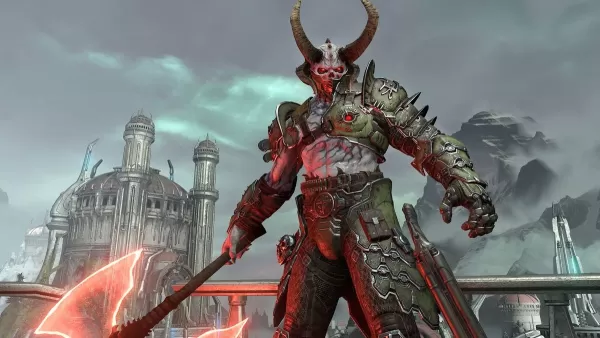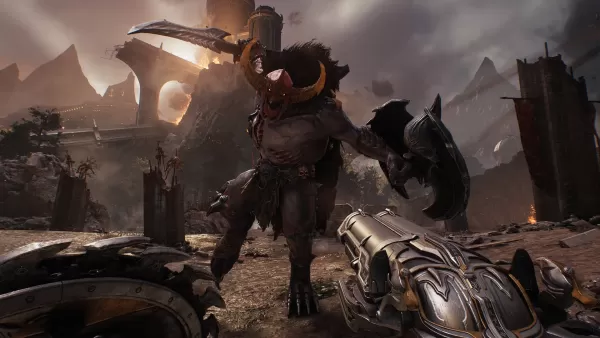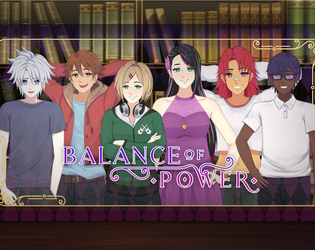When director Hugo Martin introduced the mantra for Doom: The Dark Ages as “stand and fight” during Xbox’s Developer Direct earlier this year, it immediately captured my interest. This approach starkly contrasts with Doom Eternal, a game characterized by its fast-paced, movement-based combat. However, Doom Eternal introduced one enemy that embodies this new philosophy: the Marauder. A polarizing figure in the Doom community, the Marauder is an enemy I personally adore. The revelation that Doom: The Dark Ages would hinge on reacting to bright green lights, much like defeating the Marauder, sealed my enthusiasm for the game.
Rest assured, The Dark Ages doesn't confine you to a one-on-one duel with an enemy as challenging as Eternal's Marauder. Instead, while featuring formidable foes like the Agaddon Hunter with its bulletproof shield and deadly combo attacks, the game integrates the Marauder's design principles into its overall combat system. The result is a more strategic and less frustrating experience where every encounter feels like a refined Marauder showdown.
The Marauder stands out in Doom Eternal because it disrupts the game's typical flow. While most fights in Eternal involve navigating arenas, managing hordes, and utilizing speed and strategy, the Marauder forces players to focus solely on it, often in isolated battles. This enemy requires careful positioning; too close and you'll face a lethal shotgun blast, too far and you'll be pelted with projectiles. The key to defeating it is timing your attack during the brief moment its eyes flash green, signaling the start of its axe swing.
 Doom Eternal's Marauder is one of the most controversial enemies in FPS history. | Image credit: id Software / Bethesda
Doom Eternal's Marauder is one of the most controversial enemies in FPS history. | Image credit: id Software / Bethesda
In Doom: The Dark Ages, this concept of reacting to green cues is central to gameplay. Drawing inspiration from the original Doom, enemies now launch volleys of projectiles, some of which are green and can be parried using the Doom Slayer’s new shield. Initially a defensive move, the parry evolves into a powerful offensive tool once you unlock the shield’s rune system, allowing you to stun demons or trigger your shoulder-mounted cannon.
As you traverse The Dark Ages' battlefields, combat becomes a series of focused one-on-one engagements with various demons. While the Marauder in Eternal demanded precise reactions to green lights for survival, The Dark Ages offers more flexibility. Effective use of your arsenal can lead to victory, but mastering the shield parry enhances your combat strategy significantly. The game’s parry mechanics share similarities with Marauder battles, requiring you to find the right distance and timing to effectively counter enemy attacks.
The primary criticism of the Marauder was its disruption of Doom Eternal's flow, forcing players to adopt a different strategy. Personally, I appreciate this change as it challenges the conventions of first-person shooters, pushing players to rethink their approach. However, I recognize why others found it frustrating.
 While the Agaddon Hunter may echo the Marauder's style, every demon in The Dark Ages incorporates elements of Eternal's toughest adversary. | Image credit: id Software / Bethesda
While the Agaddon Hunter may echo the Marauder's style, every demon in The Dark Ages incorporates elements of Eternal's toughest adversary. | Image credit: id Software / Bethesda
Doom: The Dark Ages addresses this by integrating varied combat styles seamlessly. Each major enemy type has unique green projectiles or melee strikes, requiring tailored strategies. For example, the Mancubus demands you weave through its energy "fences" to parry green pillars, while the Vagary's volleys resemble an abacus, challenging you to sprint and deflect specific rows. The Revenant, akin to the Marauder, requires you to deflect green skulls to damage it.
The diverse footwork needed for each enemy ensures a smooth transition when new foes appear. Although the Agaddon Hunter and Komodo introduce significant challenges with their melee combos, by this point, players are well-versed in adapting their movements and reactions.
The Marauder's design wasn't flawed; it was its unexpected deviation from Eternal's established gameplay that caught players off guard. The Dark Ages prepares players for this by making reaction-based mechanics a core element from the start, rather than a surprising mid-game shift. While the parry window in The Dark Ages is more forgiving than the Marauder's brief vulnerability, the essence of locking into an enemy's rhythm, waiting for the green light, and striking remains integral to every battle. Doom: The Dark Ages may reinterpret these concepts, but the core idea of standing and fighting is unmistakably present.















